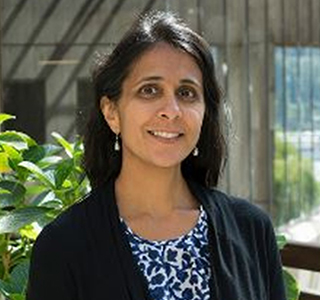December 7, 2022

Anjum Hajat, Ph.D., an associate professor of epidemiology at the University of Washington School of Public Health in Seattle, incorporates psychosocial factors — such as neighborhood socioeconomic status — into research on how air pollution affects cardiovascular disease.
In general, communities of lower socioeconomic status are exposed to more air pollution than higher socioeconomic communities, according to research published by Hajat and her colleagues.
Connecting Social Factors to Air Pollution
Hajat earned her undergraduate degree in international affairs, but near graduation she became interested in studying public health. She decided to pursue a master’s in public health at the University of Michigan, where she began developing expertise in epidemiology and health disparities in the United States.
“During my time as an undergraduate, people were talking about economic development and improving education globally, but I realized none of these goals were achievable without a healthy population,” Hajat noted. “Population health is fundamental. Once I learned about the tremendous health disparities within the U.S., I changed my trajectory from a global health focus to a domestic one, so I trained as a social epidemiologist.”
After completing her Ph.D. in epidemiology at UNC-Chapel Hill, Hajat joined a research group focused on air pollution as part of a postdoctoral program at the University of Washington.
“Air pollution and social determinants of health are appealing to me because policies can be used to address both and promote health.”
Pollution, Stressors, and Cardiovascular Disease
To pursue her research agenda on air pollution, Hajat and her collaborators are considering how exposure from psychosocial stress and air pollution across the life course affect the development of cardiovascular disease (CVD) and related health outcomes. Atherosclerosis, a process that can lead to CVD, develops when cholesterol, fat, and other substances in the blood form plaque that builds up in arteries and causes them to narrow.
In one study, supported in part by NIEHS, Hajat and her co-authors used the neighborhood deprivation index (NDI) of zip codes as the neighborhood-level social stressor indicator. The index includes several zip code-level measures of education, occupation, and income such as percentage of people with a bachelor’s degree. They found that the odds of CVD-related health outcomes like diabetes and stroke are higher in zip codes with higher social stress.
Hajat’s research on air pollution and the risks of developing CVD at the neighborhood level, not just the individual level, challenges how epidemiologists and environmental health scientists think of air pollution and the social determinants of health.
“There are two main reasons why it is important to focus on the relationship between neighborhood characteristics and air pollution,” Hajat explained. “The first is because neighborhood characteristics, like neighborhood socioeconomic status, are on the same spatial scale as air pollution. The second is because the same factors that make a neighborhood prosperous or disadvantaged can also drive the amount of air pollution exposure.”
In another study, funded by a NIEHS Exploratory/Developmental Research grant, Hajat will assess how demographic and neighborhood characteristics and air pollution influence CVD risk.
“We really need to think about how to transform communities by decreasing air pollution, changing zoning, or using redevelopment,” said Hajat. “We can greatly improve communities through regulation. This type of research should help decision-makers focus on improving the health of communities.”
Being a Mentee and a Mentor
The NIEHS Pathway to Independence Career Development Award, which Hajat won in 2014, provides up to two years of mentored, postdoctoral support and three years of independent research support.
“The Career Development Award has really put me on a trajectory to do meaningful research. In terms of mentorship and collaboration, it has opened the door for me to work with folks I had not previously worked with around the nation and the globe,” said Hajat.
Hajat serves as a mentor to up-and-coming environmental health scientists as well.
“I mentor many students who are interested in working on environmental health disparities,” she said.


